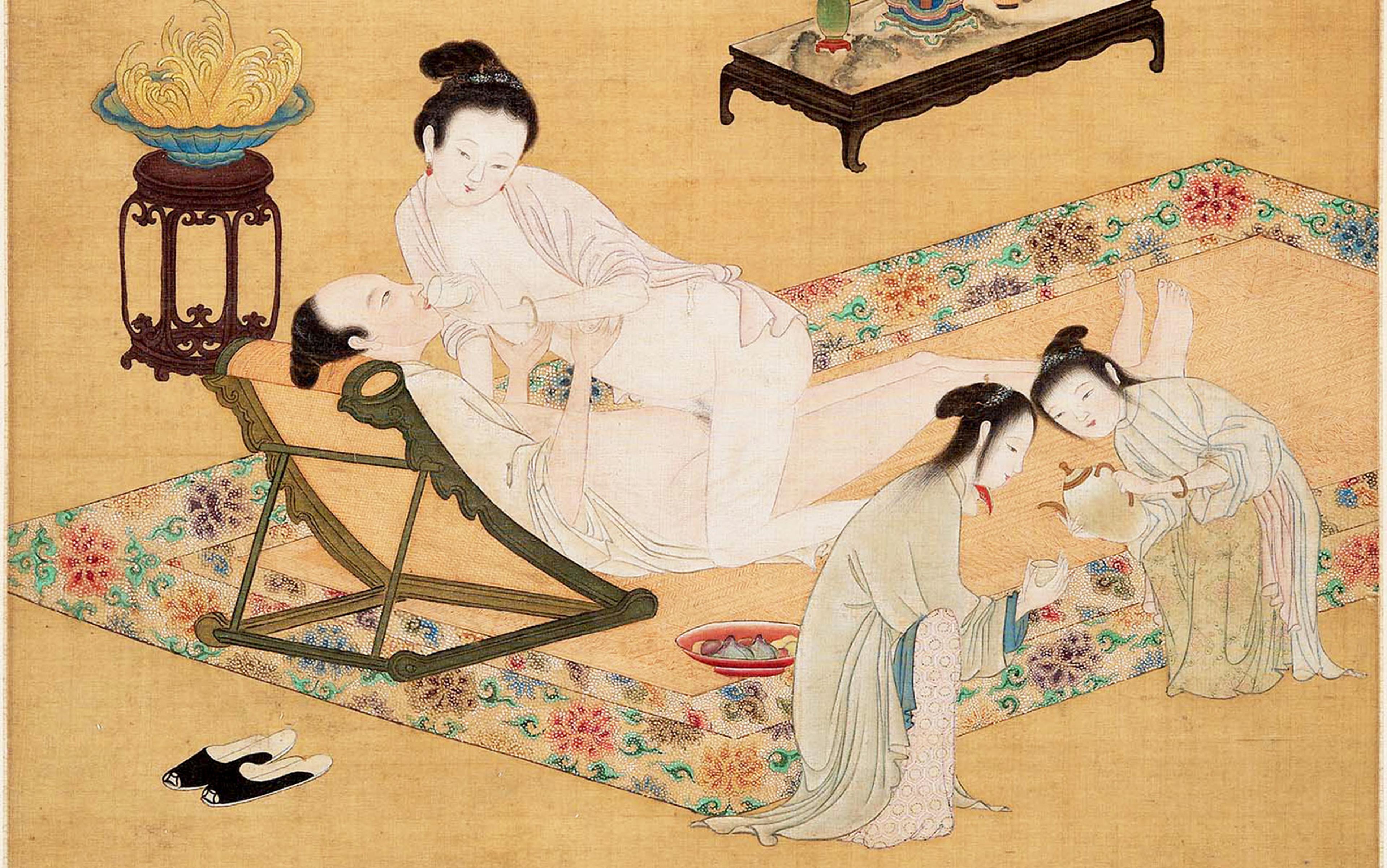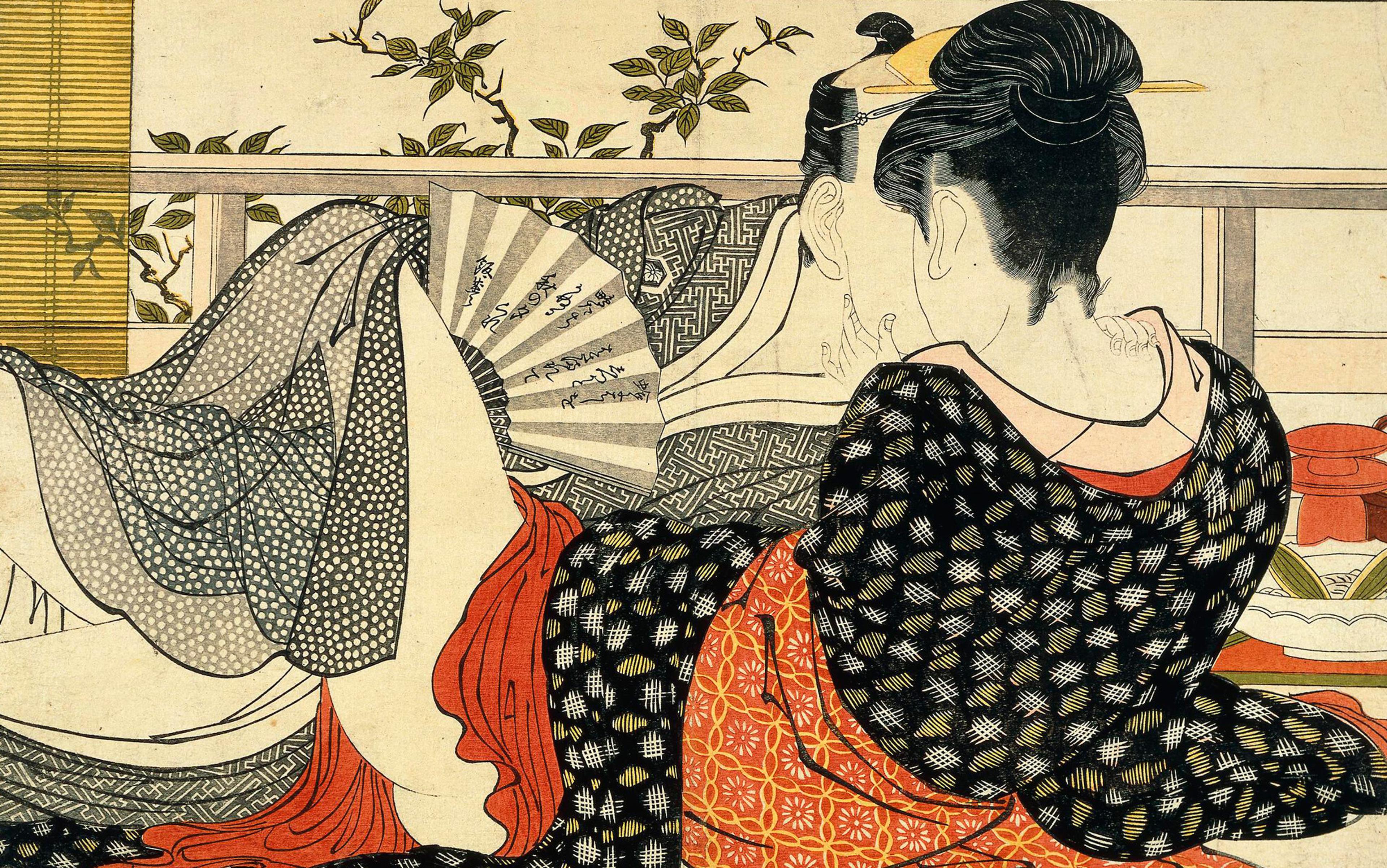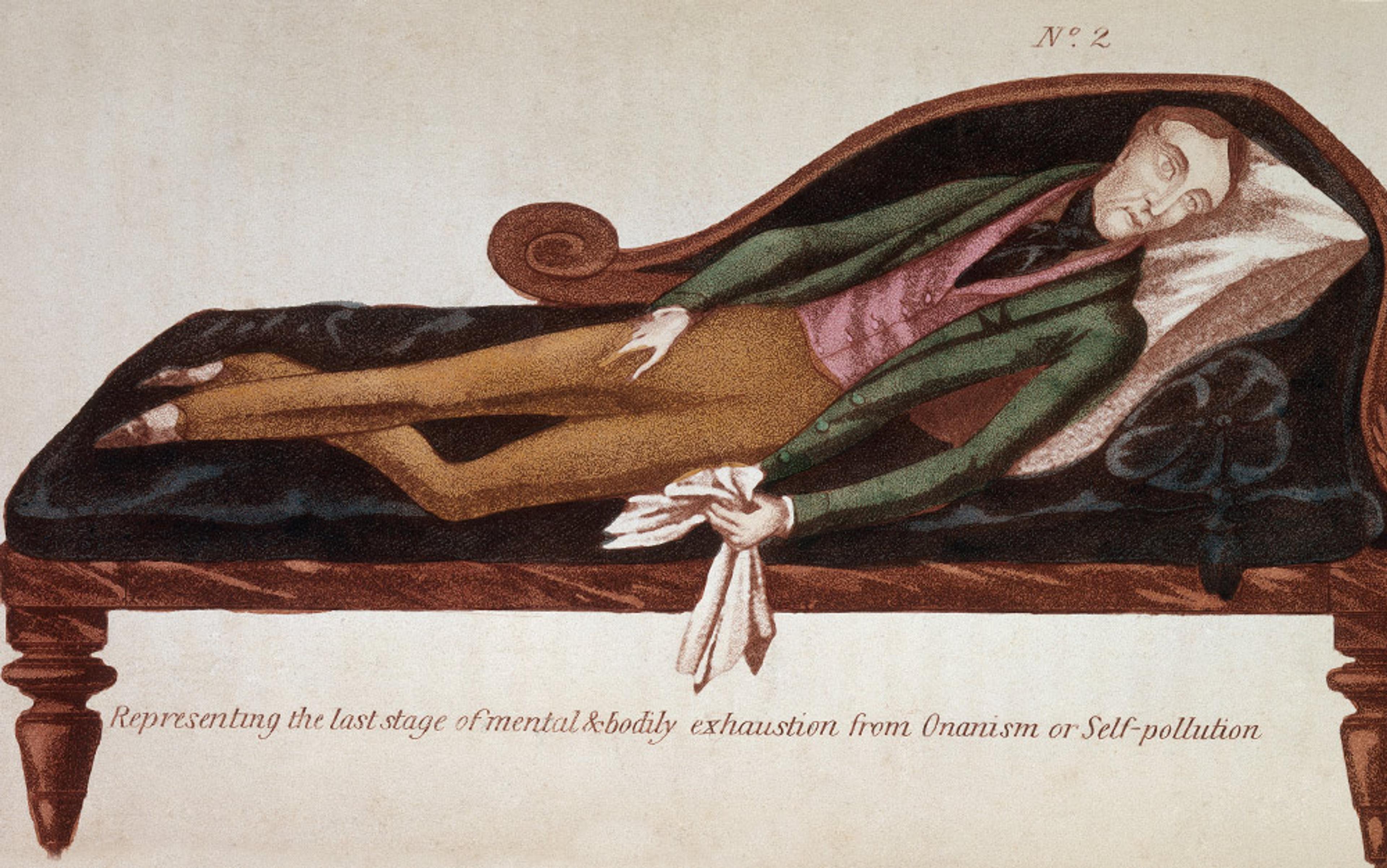Coitus reservatus, also known as ejaculation control, is the age-old practice of a man withholding ejaculation during intercourse, either through training or willpower. In our orgasm-obsessed culture, such an idea might seem counterintuitive and even perverse. After all, the male orgasm evolved over millions of years to ensure that our species kept going. Climaxing bathes the male brain in reward neurotransmitters and releases tensions men didn’t even know they had. It is the reason, some say, why men have sex at all. To hold back during sex is, therefore, to go against an existential tide. What normal man would want to renounce something that equates such explosive pleasure with basic survival?
To find out, in 2014 I travelled to Thailand to attend an ‘Eastern secrets of love’ conference, the first of what was to become an annual event that represents the greatest gathering of coitus reservatus practitioners in the world. The conference, which was also billed as a ‘Meeting of the Masters’, took place at the Tao Garden resort near Chiang Mai in northern Thailand. There I met Charles Muir, the founder of the modern Tantra movement in the United States.
Tantrism is an ancient spiritual practice that focuses on sexual ritual to achieve transcendent states. Semen is considered a sacred fluid that must be withheld and reabsorbed into the body. In China, the tenets of sexual ritual are best summed up by the Classic of Su Nu, a kind of 4th-century Taoist marriage manual. In the book, Su Nu, a goddess-courtesan, instructs the mythical Yellow Emperor on the best ways to enjoy life and sex. One should calm the mind, harmonise the emotions and concentrate the spirit before intercourse, she counsels. Then, having settled the body and composed one’s thoughts, ‘penetrate deeply and move slowly’. The male should avoid climax to stave off the inevitable bout of post-coital depression, however. ‘When ching [semen] is emitted, the whole body feels weary,’ she explains. ‘One suffers buzzing in the ears and drowsiness in the eyes; the throat is parched and the joints heavy. Although there is brief pleasure, in the end there is discomfort.’ By withholding semen, the emperor would not only stay healthy, but extend his life indefinitely. ‘Nine acts without emission, and one will enjoy unlimited longevity. Ten acts without emission, and one attains the realm of the immortals.’ Further, Su Nu says, he should have intercourse frequently, with as many partners as possible, while focusing on the pleasure of the female. In the end, the Yellow Emperor seems to have learned his lessons well. It was said he kept a harem of 1,200 women entertained, and achieved immortality.
When I met him, Muir was 65 and 6ft 4in, with blond hair, an affable expression and natural storytelling abilities. He told me he’d arrived at Tantra through a series of improbable chance events. He grew up in the Bronx in New York City, and as a teenager joined a tough Irish gang. One day, according to Muir, he found a yoga pamphlet on the subway seat. He began to watch the TV shows of the yoga instructor Richard Hittleman, and eventually worked for him. As Muir’s interest grew, he studied under some of the original Indian yoga masters, including the swamis Satchidananda, Muktananda and Satyananda. These revered yogis taught him that the true path lay not only in disciplining the mind and body, but in celibacy. Muir struggled with sexual abstinence and he was stunned when, one after the other, these Indian gurus were exposed for having sex with their students. There he was feeling guilty each time he had an emission, while all of his teachers were hard at it.
Discouraged, he wanted to move to California, but didn’t have the money until he won $50,000 on a New York State lottery ticket. He settled in Carmel, near San Francisco. There he met Caroline, his future wife, who introduced him to Tantra and the possibility of keeping an open but committed relationship. Through their own experiments in their Hawaiian retreat, Charles and Caroline created a system for modern couples that was only loosely based on tantric tradition. As their fame grew, the Muirs’ list of clientele began to include Hollywood actors, directors and producers; the director Lance Young wrote and directed a feature film, Bliss (1997), in which the Charles Muir character was played by Terence Stamp. The Muirs later divorced, but they continue to work together, and have trained thousands in the sexual techniques they developed.
In the West, coitus reservatus dates back at least to Roman times, and has a well-documented place in US history beginning in the mid-19th century with the founding of the utopian Oneida Community in upper New York State. There, the followers of the minister John Humphrey Noyes, a cousin of US president Rutherford B Hayes, practised coitus reservatus as a crude but workable form of birth control. Young men were trained in the art by older women who stood little chance of getting pregnant should a mistake occur. ‘Male Continence’, as Noyes called it – since it placed male gratification on the back burner – liberated the female orgasm from the long Victorian winter it had been experiencing. It allowed members of the group to practise free love (monogamy was forbidden), and created an equality between men and women, both inside and outside the bedroom, that was almost unthinkable in that era. (The women of Oneida cut their hair short, wore pants and were encouraged to do men’s work.) Through coitus reservatus, the humdrum act of intercourse turned into a spiritual and even artistic endeavour. ‘Indeed,’ said Noyes, ‘it will take rank above music, painting, sculpture, etc; for it combines the charms and benefits of them all.’
The Oneida experiment was so successful that it inspired a generation of women’s rights pioneers and birth-control advocates in the US, including Margaret Sanger and Ida C Craddock, to push for coitus reservatus into the early 20th century. The most common term then was ‘Karezza’, coined from the Italian for ‘caress’ by the Chicago-based gynaecologist and public-school reformer Alice Bunker Stockham. Her chief interest was in the plight of the orgasm-starved working woman, but she addressed her appeal to their husbands, who must, after all, wield the sword. Writing in 1896, Stockham said:
Men who are borne down with sorrow because their wives are nervous, feeble and irritable, have it in their own power, through Karezza, to restore the radiant hue of health to the faces of loved ones, strength and elasticity to their steps and a harmonious action of every part of the body.
By the 1960s, with the dissemination of reliable birth-control methods and the rise of the women’s movement and sexual liberation – the foundations for which had been at least partially laid by the Oneida Community – coitus reservatus was in danger of becoming a mere historical oddity, destined to go the way of the whalebone stay and the bustle, were it not for the somewhat quixotic support of two English writers transplanted to California, Aldous Huxley and Alan Watts.
‘Let this interchange continue for an hour or more, during which the female orgasm may occur several times’
Huxley – a savage social satirist, known chiefly for his dystopian farce Brave New World (1932) – had been worried about ‘adolescents coming to maturity [who] were left to work out their sexual salvation, unassisted, within the framework of the prevailing and generally barbarous socio-legal system’. He wrote a novel about being shipwrecked on a tropical paradise where the natives spoke English (and apparently Hindi) and mated freely with one another using Maithuna, a ‘yoga of love’ that the author admitted was ‘basically’ Male Continence. With Maithuna, men and women, but especially women, were ‘transformed, and taken out of themselves and completed’. For Huxley, who died in 1963, that novel, Island (1962), was a final word on how he thought the world ought to be run.
Watts, who was both an Anglican priest and a Zen Buddhist, advocated for coitus reservatus as a form of meditation and spiritual communion that was far superior to normal intercourse, which he defined as a mere ‘sneeze in the loins’. What he called ‘contemplative love’ was ‘only quite secondarily a matter of technique’, he wrote in 1958. ‘For it has no specific aim; there is nothing particular that has to be made to happen. It is simply that a man and a woman are together exploring their spontaneous feeling – without any preconceived idea of what it ought to be, since the sphere of contemplation is not what should be but what is.’ Describing the connection that can arise between partners at the moment of penetration, when male orgasm is no longer the object, he said:
It is at this juncture that simple waiting with open attention is most rewarding. If no attempt is made to induce the orgasm by bodily motion, the interpenetration of the sexual centres becomes a channel of the most vivid psychic interchange … Although the man does nothing either to excite or withhold orgasm, it becomes possible to let this interchange continue for an hour or more, during which the female orgasm may occur several times with a very slight amount of active stimulation, depending upon the degree of her receptivity to the experience as a process taking charge of her … it may happen that they prefer simply to remain still and let the process unfold itself at the level of pure feeling, which usually tends to be the deeper and more psychically satisfying way.
To be frank, my first impression of the Tao Garden’s conference was that it could have made a delicious subject for another Huxley satire, à la Brave New World. The clinic offered every kind of New Age therapy imaginable, including blood irradiation with strange blue light, Ayurvedic massage, colonic irrigation, full-body cupping, and a very painful treatment where so-called granules in the blood vessels of your anal canal and testicles are squeezed flat by muscular Thai grandmothers. The ecstatic screams of Tantra’s female acolytes were so loud at night that nearby condo owners threatened to call the police. My wife sensibly spent most of her time sunning herself by the swimming pool, sipping pineapple drinks, and watching the well-muscled tantrikas do laps in their G-string briefs, while I attended lectures and demonstrations in such subjects as ‘Preserving the Yang Element’, ‘Nine Sexual Secrets’ and ‘Awakening the Goddess’.
The highpoint of the conference was a public demonstration of ejaculation control training for which a young man among Muir’s followers had volunteered. (At lunch that day, the same young man had told my wife and me that he was torn between dedicating himself to Tantra and becoming a dentist as his parents fervently wished.) The demonstration took place in a large room whose only furnishings were floor mats. As the young man disrobed and lay down, Leah Alchin Piper, Muir’s former lover and now business partner, opened her shirt and began pummelling his erection with her bare breasts. Given the choice between taking the proceedings to orgasm, or remaining in a state of high arousal, he picked the latter. (Muir claims that tantric arousal reaches a scale of 10, while normal intercourse seldom rises above a six.) As Alchin Piper continued to stimulate his ‘jade stalk’ with her hands, breasts, elbows and knees, the young man seemed to go into an altered state. At one point during the pummelling, the audience was invited to ask him questions. At first, the queries were anodyne. ‘How are you feeling?’ ‘Good.’ Then someone asked: ‘Is there anything you want to tell your parents?’ To which he responded: ‘I want to tell them to leave me alone!’
Watching this vulnerable performance, it occurred to me that perhaps this young man’s tantric training was similar to that which adolescent men had received from mature women in the Oneida Community in the 19th century. The focus of such training, then as now, is usually on increasing women’s pleasure, but what happens, mentally and physically during intercourse to a man when he has completed his ‘training’ and intentionally foregoes ejaculation? In the current deplorable state of the science of human sexuality, where few studies are funded and academics are discouraged from research, we have very little direct knowledge, but certain things can be inferred.
Theoretically in tantric sex, as Watts noted, the partners have more time to contemplate one another – to literally stare into each other’s eyes. Several studies have shown that gazing into another person’s eyes for a length of time increases empathy and self-awareness, enhances memory, and causes one to view the other in a more positive light. Further, the anthropologist Helen Fisher has found, using fMRI scans, that merely viewing a photograph of one’s beloved unleashes a flood of neurochemicals – testosterone, oxytocin, dopamine, norepinephrine – that amp up feelings of tenderness and attraction. Meanwhile, serotonin levels drop, indicative of obsessive thinking and, deep in the reptilian brain, the caudate nucleus, associated with hunting prey, lights up. ‘Drenched in chemicals that bestow focus, stamina, and vigour, and driven by the motivating engine of the brain,’ Fisher concluded, ‘lovers succumb to a Herculean mating urge.’ Another study showed that the mere witnessing of a sex act, even if it is only on film, triggers so-called ‘mirror’ neurons in the male brain, causing him to feel that what he sees is actually happening to himself. Presumably, seeing a partner dissolve in ecstasy in one’s arms would have the same effect and would be highly pleasurable.
In the neo-tantric community, the plateau that excludes orgasm is seen as wholesome, long-lasting and healthy
Then there’s the hug factor. Oxytocin is a neurotransmitter that is released when two people embrace (and, in women, when they breastfeed). Oxytocin enhances feelings of trust, of wellness, tranquility and love. For example, it’s been shown that a gambler will be more trusting of his opponents after inhaling a whiff of oxytocin. With oxytocin, social and sexual intimacy become more pleasurable, and two people flushed with oxytocin are more likely to bond. Partners at the beginning of their relationship – say, the first six months – have high levels of oxytocin as they fall for one another. No wonder it’s often referred to as ‘the love hormone’. (However, there is some evidence that, in the same way that oxytocin plays a role in binding people together, it also increases hostility for out-groups.)
On the other hand, what Anaïs Nin has called ‘the gong of the orgasm’ causes an explosion of the neurotransmitter dopamine in the brain, giving rise to feelings of ecstasy and even grandiosity. Dopamine also floods the brain when one ingests cocaine or gambles, and is thus medically considered a facilitator of addiction. (Certainly there are sex addicts.) This physiological function has given rise, in some parts of the neo-tantric community, to a perceived moral dichotomy, in which orgasm is viewed as habit-forming and therefore negative, with easy thrills leading to a depressive aftermath and the seeking of further thrills, in an endless cycle, while the plateau that excludes orgasm is seen as wholesome, long-lasting and healthy.
Some signs indicate that orgasm is not the holy grail it’s often thought to be. In 2009, the US National Survey of Sexual Health and Behaviour found that 36 per cent of women and 10 per cent of men did not orgasm during their last sexual intercourse. Nonetheless, according to Sex in America: A Definitive Survey (1994) by Robert Michael et al, the majority are content with their erotic state:
Considering the enormous emphasis that has been placed on orgasms – how to achieve them, how crucial they are supposed to be to physical satisfaction – our data are unexpected. Despite the fascination with orgasms, despite the popular notion that frequent orgasms are essential to a happy sex life, there was not a strong relationship between having orgasms and having a satisfying sexual life.
In this light, the deliberate shifting away from orgasm opened up by tantric sex could have real merit.
However, ancient claims that withholding semen extends a man’s longevity are hard to take seriously. In fact, it’s having orgasms that appears to extend life and health. For example, a British study of 918 men in small towns in south Wales found that those who experienced eight orgasms a month had half the death rate of those who had less than one a month. From this, Michael Roizen, who chairs the Wellness Institute at the Cleveland Clinic in Ohio, has speculated that a man who has 350 orgasms a year will live four years longer than his neighbour who has the national average of about 88 per year. Women, too, sleep better, weigh less and live longer with more orgasms. But perhaps orgasm is beside the point. It might be that it’s solely the number of sexual contacts that increases lifespan. A Duke University study that followed 252 people over 25 years concluded in 1985 that ‘frequency of intercourse was a significant predictor of longevity’. Presumably, those in the Duke study produced the same ratio of orgasms to coition as those tabulated in the national survey. What it does to a man’s life expectancy to ejaculate only once a month, as Muir claims to do, is anyone’s guess.
Some intriguing hints about the connection between bodily health and sexual stimulation can be found in a study conducted in 2012 by Barry Komisaruk, a pioneer researcher on the effects of orgasm in the brain. Komisaruk and his team at Rutgers University in New Jersey showed that women whose spinal cords had been severed through car accidents or gunshot wounds could still have orgasms when their genitals were stimulated. This surprising result occurred because the nerve impulses of arousal were apparently reaching their brains via an alternative route, the vagus nerve, the so-called ‘wandering’ neural pathway that winds its way up from the genitals to the base of the brain, touching the heart, lungs, upper digestive tract and other organs of the body as it passes. The vagus nerve is essential for the parasympathetic, or involuntary, control of the heart, lungs and digestive tract. Thus, the claims of increased organic health through extended sexual stimulation might have some basis in human physiology, although little has been done to look further into the implications of Komisaruk’s discovery.
Finally, it’s estimated that a third of all American men suffer from problems with premature ejaculation. In an interview, the sex therapist and author Ian Kerner, a self-admitted premature ejaculator himself and author of the book She Comes First (2004), told me that tantric training to curb ejaculation could be a valuable addition to other treatments for his clients, among whom premature ejaculation is a prime problem.
It remains to be asked whether Muir’s Tantra is Tantra at all. David Gordon White, a professor of comparative religions at the University of California, Santa Barbara, does not think so. ‘New Age Tantra is to medieval Tantra what finger painting is to fine art,’ he asserts. Mentioning Muir by name, he almost exhausts his vocabulary when he describes the ‘funhouse mirror world’ of contemporary Western Tantra, calling it an ‘invented tradition’, ‘a consumer product’, a ‘derivative, dilettante, diminished rendering of a sophisticated, coherent, foreign, and relatively ancient tradition’.
The true ‘perennial’ religion that White discovered on his many trips to rural India exists in a timeless state in the villages, thriving wherever intellectuals, academics and urban elites are not. It is a primitive shamanistic set of beliefs in which a pantheon of voracious, angry, mostly female deities, stemming from nearby mountains, rivers and trees, must be appeased by blood sacrifice and the production and consumption of ‘powerful, transformative sexual fluids’. According to White, attempts to sanitise this raw sexual religion started as early as the 11th century, when Hindi scholars began to emphasise ‘a divine state of consciousness homologous to the bliss experienced in sexual orgasm’ that was never part of true Tantra. In the 19th century, Western scholars studied this cosmeticised version, salting it with their own romantic and orientalist ideals. Thence began a strange feedback loop, says White, ‘in which Indian practitioners and gurus [began to] take their ideas from Western scholars and sell them to Western disciples thirsting for initiation into the mysteries of the East.’
In terms of meditation, it was the purest state I’d ever experienced, as all sense of self ceased to exist
While condemning, in the strongest terms, their appropriation of the word Tantra, White concedes that many Western ‘Tantric sex’ gurus such as Muir are ‘well-meaning people, who have offered their clients a new and liberating way of experiencing and enjoying their sexuality’. It’s important to point out that Muir claims only to have been inspired by traditional Tantra. The bulk of his programme, aside from ejaculation control, is focused on creating a state of loving harmony. He advises couples to become ‘teammates’, hugging in spoon fashion twice a day in ‘nurturing meditation’, running, biking, walking and even working together, but above all communicating – sharing thoughts, dreams, fears and fantasies – advice that any marriage counsellor might give.
Perhaps it would be more useful to see his form of ‘tantra’ within a wider Western tide of expropriation of Eastern traditions that coincided with colonial expansion all over the world. One thinks of Ralph Waldo Emerson and Henry David Thoreau reading from the Bhagavad Gita in translation every day and from it creating new expressions of philosophy and closeness to nature unknown in New England back then, or of the French Impressionists viewing Japanese prints and exploding beyond the Renaissance perspective. American entrepreneurism focused around coitus reservatus might have begun through just such 19th-century seepage of thought starting with the Oneida Community and continued up into the 20th century, conveyed by idealists, birth-control advocates, renegade writers and feminist activists, where it arguably laid a basis for the sexual revolution and the women’s movement.
The night after the demonstration with the young man, my wife and I were issued a small cup of massage oil and several sticks of incense, and asked to replicate in private what we’d seen. I lay back on a mat while my wife, Hali, turned off the lights and lit the incense. Desiring to have the full tantric experience, I asked her to forgo the ‘happy ending’. All thoughts in my head disappeared. In terms of meditation, it was the purest state I’d ever experienced, as all sense of self ceased to exist. Perhaps this is what is known as ecstasy, which means literally to stand outside of oneself.
Although Hali and I came away from the conference with our sex life relatively unchanged, I still find myself intrigued by this alternative sex method that is so firmly established in small but persistent pockets of our society. Considering the current lack of serious research into human sexual function by the scientific establishment, I believe it’s time to take another look at this obscure, but time-honoured practice that seems to hold so much promise for expanding our understanding of, and pleasure in, sex.






